经济合作与发展组织科技创新报告(2012年OECD权威报告书)
经济合作与发展组织(OECD)中的GLP审查管理规范

总结
• 颁布国家GLP管理监督规范是OECD关于 数据资料相互认可决议的一部分
• 该规范的制定与执行应与OECD的相关规 范一致
• 这一规范保证了实验室所提供数据的质量 和可靠性
进行回答 • 校正一些轻微的GLP偏差 • 严重的GLP偏差:
– 修订实验室负责人的GLP管理规范 – 认为试验和设施是不符合规范的
– 法律制裁(在英国,这些被认为是触犯法律的)
上诉程序
• 任何意见分歧都应该在审查期间得到解决 • 如果不能完成上述要求,应建立一个允许
实验室阐述观点的机制
在英国,采用逐级上诉程序:
• 履行审查义务 • 通常每两年审查一次(大型实验室每年审
查一次) • 有特定原因的审查 • 其他审查
审查员的国,GLP审查员拥有可证明审查员身份的许 可证,并确保其合法权利:
– 进入实验室检查 – 检查或提取试验数据和记录 – 向相关人员询问
审查和监督后的工作
• 书写审查报告 • 要求实验室管理部门对审查员发现的问题
多场所/跨地域试验-13)
• GLP规范对下列部门/人员的具体要求
(质量保证-4篇,供应厂商-5篇、试验负责人- 8篇、 试验委托方-11、计算机系统-10)
• 国家GLP审查管理规范的指南
OECD相关规范
国家GLP审查管理规范的指南
• GLP审查管理规范指南-2篇 • 实验室审查和监督执行指南-3篇 • GLP审查报告书写指南-9篇 • 在其他国家请求实施GLP检查和试验审核-
经济合作与发展组织 (OECD)中的GLP审查管
理规范
史蒂芬 ·蒙克 特级监察员 英国药品监督管理局GLP监察局
经济合作与发展组织(OECD)
经济合作与发展组织

秘书处有1位秘书长和4位副秘书长领导,秘书长也是理事会主席,并负责在秘书处与各国代表团间的联络与协调。OECD的工作语言有英语和法语,其工作人员虽是OECD成员国的公民,但在OECD工作期间作为国际组织的职员并不带有各自国家的观点。
OECD的职能主要是研究分析和预测世界经济的发展走向,协调成员国关系,促进成员国合作。OECD主要关心工业化国家的公共问题,也经常为成员国制定国内政策和确定在区域性、国际性组织中的立场提供帮助。
冷战结束后,特别是进入九十年代以来,OECD积极发展同非OECD国家,包括发展中国家的关系,目前有33个国家和地区作为OECD联系国家,经常参加OECD组织的对话合作活动。
1998年成立了非成员国合作研究中心,负责OECD与非成员国的所有活动。该中心设有两类项目:一类是以政策为主题,例如贸易、投资、税收、环境,把OECD成员国与非成员国联系在一起;另一类是以国家或地区为基础,其中主要是与俄罗斯以及与中国的合作项目。
OECD主要是通过下列机构长期从事对发展中国家的工作,并与这些国家保持联系:发展资助委员会;发展中心,研究发展中国家的社会与经济问题;sahel俱乐部,在西非sahel地区的国家和OECD成员国资助机构间进行协调的论坛。有一位副秘书长管理这些合作活动以保证与非成员国合作中心项目间的协调。
粮食、农业及渔业司
主要业务领域是对农场收入的补贴、在教育与培训方面对农业的支持,关注政策的改革以及农业市场和贸易的前景,致力于使农业生产和市场更为有
注册城乡规划师考试:2020注册城乡规划师《城乡规划实务》真题模拟及答案(3)
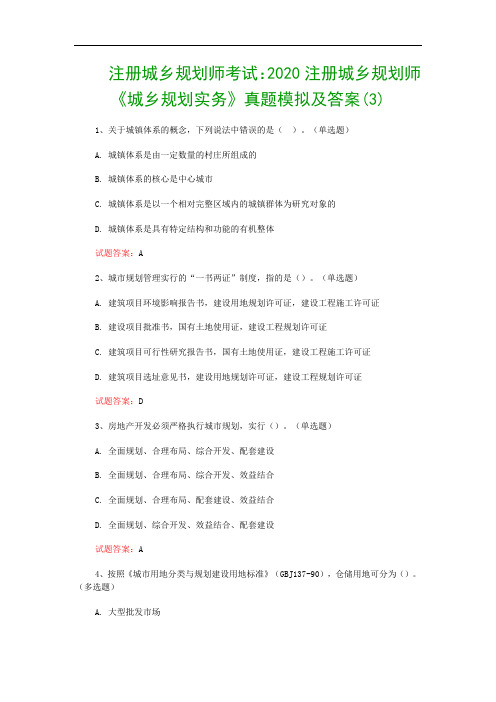
注册城乡规划师考试:2020注册城乡规划师《城乡规划实务》真题模拟及答案(3)1、关于城镇体系的概念,下列说法中错误的是()。
(单选题)A. 城镇体系是由一定数量的村庄所组成的B. 城镇体系的核心是中心城市C. 城镇体系是以一个相对完整区域内的城镇群体为研究对象的D. 城镇体系是具有特定结构和功能的有机整体试题答案:A2、城市规划管理实行的“一书两证”制度,指的是()。
(单选题)A. 建筑项目环境影响报告书,建设用地规划许可证,建设工程施工许可证B. 建设项目批准书,国有土地使用证,建设工程规划许可证C. 建筑项目可行性研究报告书,国有土地使用证,建设工程施工许可证D. 建筑项目选址意见书,建设用地规划许可证,建设工程规划许可证试题答案:D3、房地产开发必须严格执行城市规划,实行()。
(单选题)A. 全面规划、合理布局、综合开发、配套建设B. 全面规划、合理布局、综合开发、效益结合C. 全面规划、合理布局、配套建设、效益结合D. 全面规划、综合开发、效益结合、配套建设试题答案:A4、按照《城市用地分类与规划建设用地标准》(GBJ137-90),仓储用地可分为()。
(多选题)A. 大型批发市场B. 普通仓库用地C. 危险品仓库用地D. 堆场用地E. 物流中心试题答案:B,C,D5、有关城市环境质量的监测数据,包括()等,主要反映现状中的城市环境质量水平。
(多选题)A. 大气B. 水质C. 污染物排放D. 噪声E. 气候试题答案:A,B,D6、经济合作与发展组织(OECD)的《1996年度科学、技术和产业展望》提出“以知识为基础的经济”概念,其定义是()。
(单选题)A. 以知识创造财富B. 将知识直接投入到生产、分配的环节C. 知识经济直接以生产、分配和利用知识与信息为基础D. 知识、信息直接利用的生产、销售和分配试题答案:C7、金属表面除锈是利用各种酸溶液或碱溶液达到除锈目的处理方法属于方法。
()(单选题)A. 人工B. 机械C. 喷射D. 化学试题答案:D8、主干法的主要内容是以下()方面的法律条款。
2012年全球创新指数排名及国别数据分析

2012年全球创新指数排名及国别数据分析欧洲工商管理学院和世界知识产权组织于2012年7月联合发布了题为“增强创新联动,促进全球增长”的全球创新指数报告。
该报告基于创新能力和成果对141个国家/地区进行了排名,瑞士、瑞典和新加坡在整体创新表现方面名列前三位。
全球创新指数今年是世界知识产权组织第5次发布全球创新指数报告。
研究人员通过能够体现创新活动的5个创新投入次级指数以及构成创新成果实证的两个创新产出次级指数对全球创新活动予以评估。
两个次级指数的平均值构成全球创新指数,两者间的比率则构成创新效率指数。
详见2012全球创新指数框架图(图1)。
创新国家类型根据一国的创新表现与其收入水平之间的关系(人均gdp ppp$),可以把国家和地区分为三类。
1)创新领导者:成功创建了创新生态体系,对人力资本和稳定的创新基础设施提供支持的高收入国家/地区。
其中排名前十的国家/地区为瑞士、瑞典、新加坡、芬兰、联合王国、荷兰、丹麦、中国香港、爱尔兰和美国。
2)创新学习者:改善了体制框架,拥有技能熟练、训练有素的劳动者队伍,拥有更好的创新基础设施和成熟商业界,因而不断提高创新水平的中等收入国——尽管该国在各领域某些方面的进展可能存在并不均匀的情况。
其中包括拉脱维亚、马来西亚、中国、黑山、塞尔维亚、摩尔多瓦、约旦、乌克兰、印度、蒙古等。
在低收入国家中,肯尼亚和津巴布韦脱颖而出。
3)创新表现欠佳者:那些根据其收入水平具有创新潜力,但其创新制度中存有缺陷的国家,其中包括若干高收入国家,如卡塔尔、阿联酋、阿曼、文莱、科威特、希腊、特立尼达和多巴哥;若干中等收入国家,如阿根廷、白俄罗斯、墨西哥、博茨瓦纳、巴拿马、伊朗、加蓬、委内瑞拉、阿尔及利亚、叙利亚等。
创新行动要点在经济危机期间进行创新投资至关重要。
创新不能解决最紧急的金融困难,却是可持续增长和未来繁荣的一个关键要素。
经济危机期间的业务不确定性使得许多大型跨国公司宁愿积累现金也不愿投资于研发。
OECD的科技统计与科技指标
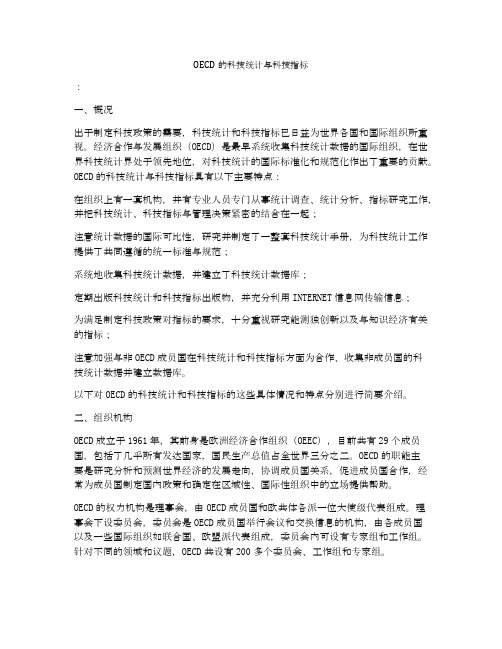
OECD的科技统计与科技指标:一、概况出于制定科技政策的需要,科技统计和科技指标已日益为世界各国和国际组织所重视。
经济合作与发展组织(OECD)是最早系统收集科技统计数据的国际组织,在世界科技统计界处于领先地位,对科技统计的国际标准化和规范化作出了重要的贡献。
OECD的科技统计与科技指标具有以下主要特点:在组织上有一套机构,并有专业人员专门从事统计调查、统计分析、指标研究工作,并把科技统计、科技指标与管理决策紧密的结合在一起;注意统计数据的国际可比性,研究并制定了一整套科技统计手册,为科技统计工作提供了共同遵循的统一标准与规范;系统地收集科技统计数据,并建立了科技统计数据库;定期出版科技统计和科技指标出版物,并充分利用INTERNET信息网传输信息;为满足制定科技政策对指标的要求,十分重视研究能测独创新以及与知识经济有关的指标;注意加强与非OECD成员国在科技统计和科技指标方面为合作、收集非成员国的科技统计数据并建立数据库。
以下对OECD的科技统计和科技指标的这些具体情况和特点分别进行简要介绍。
二、组织机构OECD成立于1961年,其前身是欧洲经济合作组织(OEEC),目前共有29个成员国,包括了几乎所有发达国家,国民生产总值占全世界三分之二。
OECD的职能主要是研究分析和预测世界经济的发展走向,协调成员国关系,促进成员国合作,经常为成员国制定国内政策和确定在区域性、国际性组织中的立场提供帮助。
OECD的权力机构是理事会,由OECD成员国和欧共体各派一位大使级代表组成。
理事会下设委员会,委员会是OECD成员国举行会议和交换信息的机构,由各成员国以及一些国际组织如联合国、欧盟派代表组成,委员会内可设有专家组和工作组。
针对不同的领域和议题,OECD共设有200多个委员会、工作组和专家组。
OECD的日常工作机构是秘书处,设在巴黎OECD总部。
秘书处下设司或部,每一个司服务于一个或若干个委员会、委员会的工作组或专家组。
经济合作与发展组织
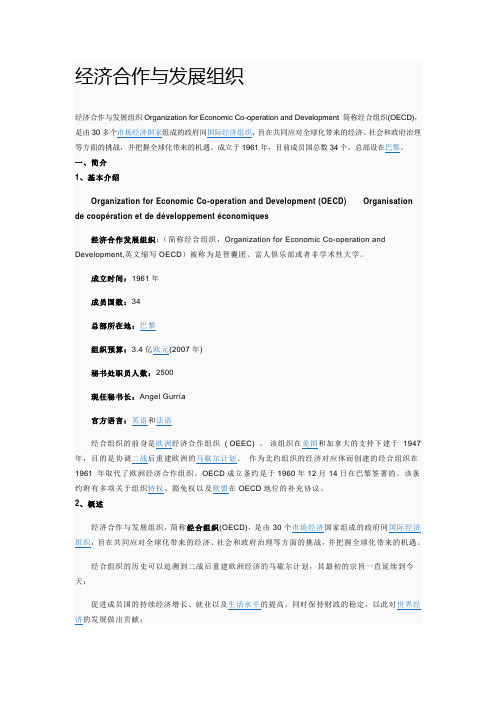
三十个成员国的代表在专业委员会会面,就具体政策领域,如经济、贸易、科学、就业、教育及金融市场,提出建议并审议在这些领域所取得的进展。
经合组织共有约二百个委员会、工作组和专家小组。
每年有四千多名来自各成员国政府部门的高级官员参加经合组织委员会会议,对经合组织秘书处开展的工作提出要求,进行审议并发挥作用。
即使在自己的国家,他们也可以通过网上途径获得经合组织的文件,并通过特别联网交换信息。
3、理事会理事会是经合组织的决策机构,由每个成员国及欧洲委员会各派一名代表组成。
理事会定期召开成员国驻经合组织大使级会议,并通过综合一致意见的方式进行决策。
理事会每年举行一次部长级会议,讨论重要问题,并为经合组织的工作确定重点。
理事会指定的工作则由经合组织秘书处的各个司局来完成。
4、秘书处经合组织秘书处设在巴黎,两千多名工作人员支持着委员会的工作。
七百多名经济学家、律师、科学家和其他专业人员从事研究和分析工作。
他们主要分布于十二个业务司局。
秘书处的工作是和委员会的工作平行的,每个司局服务于一个或多个委员会,以及委员会属下的工作组和分组。
秘书处由一名秘书长领导,四名副秘书长协助工作。
秘书长还是理事会主席,是成员国代表团和秘书处之间的重要联系。
英语和法语是经合组织的两种官方工作语言。
经合组织的职员都是成员国公民,但他们在经合组织任职期间以国际行政人员的身份工作,不代表各自国家。
经合组织对职员的国别没有配额限制,只本着平等机会的政策,聘用来自各个国家,拥有不同领域经验的高素质人员。
5、资金来源经合组织是由其三十个成员国资助的。
各国向经合组织年度预算捐款的比例根据一个与其经济规模相关的公式而确定。
最大捐款国是美国,它提供了经合组织预算的四分之一,其次是日本。
经过理事会批准,各国也可以向一些特殊活动或项目提供不包括在主要预算之内的单独资助。
经合组织的年度预算及工作方案都由理事会决定。
目前经合组织的年度预算约为三亿欧元。
四、功能和运作经合组织在政策研究和分析的基础上,提供一个思考和讨论问题的场所,以帮助各国政府制定政策,这些政策可能促成成员国政府间的正式协议,也可能在国内或其它国际场合实施。
经济合作与发展组织(OECD)发布《中期经济展望报告》
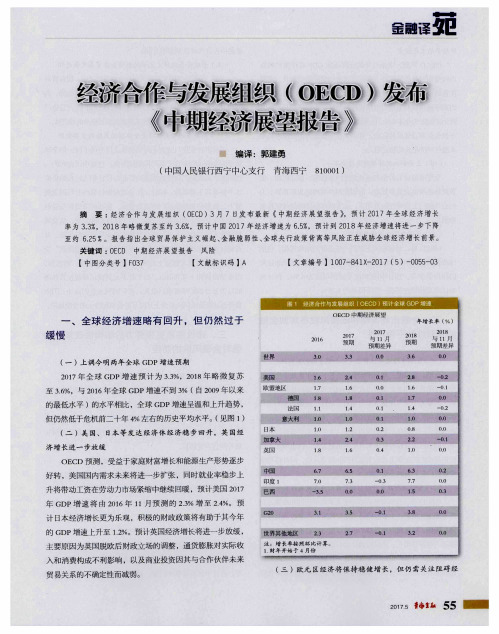
些 困家 ,私人部 门信贷 的快速 增 k 和与 以 市 n 比较 舟 的负债
水平将 足其主要风险 ,同时 ,在全球利率较低 的有利因 素刺 激下 ,特别是非会融部 门的高负债率 ,使其经济 更容 易受利 率快速 上升或不利 因素的影响。对 于印度 和俄 罗斯 ,信贷 期导致 不 良贷款的上 升可能会暴露 出资本 期限 锚配风险 ,许 对银行 体系形成压 力。在中罔 ,不 良贷款 和 “ 特别提款 ”贷 款 的高 比例在 很大程度 上反 映 了罔 有企 业的借贷 。对巴西 、
关键词 : O E C D 中期经济展望报告 风 险
【 中图分 类号 】 F 0 3 7
【 文献标识 码 】 A
【 文章编号 】 1 0 0 7 - 8 4 1 X - 2 0 1 7( 5 ) - 0 0 5 5 — 0 3
一
、
全球 经济增速 略有 回升 ,但 仍然过 于
z
—■●
金 融 译 巳
经济合作与发展组织 ( O E C D) 发布
编译 :郭建勇
( 中国人民银行西宁 中心支行
青海西宁
8 1 0 0 0 1 )
摘 要 : 经济合作 与发展 组织 ( O E C D) 3月 7日发 布最新 《中期经济展 望报告 》 ,预计 2 0 1 7年全球 经济增长
率为 3 . 3 % ,2 0 1 8年略微 复苏至约 3 . 6 皇 ; ,预计 中国 2 0 1 7年经济增速为 6 . 5 茗 ,预计到 2 0 1 8年 经济增速将进 一步下 降
至约 6 . 2 5 %。报告指 出全球 贸易保护主义崛起 、 金融脆 弱性 、 全球 央行政策背离等风 险正在威胁全球经济增 长前景。
2022-2023年中级银行从业资格之中级银行管理练习题(二)及答案 - 副本

2022-2023年中级银行从业资格之中级银行管理练习题(二)及答案单选题(共50题)1、《流动性办法》要求管理信息系统应实现的功能不包括( )。
A.支持对融资抵(质)押品信息的监测B.每日计算各个时间段的现金流入、流出及缺口C.及时计算流动性风险监管和监测指标D.支持对维度的流动性风险的实时监控【答案】 D2、国内商业银行面临的最主要和最常见的利率风险形式为()。
A.重新定价风险B.收益率曲线风险C.基准风险D.期权性风险【答案】 A3、理财产品风险评级结果应当以风险等级体现,由低到高至少包括()个等级,并可以根据实际情况进一步细分。
A.3B.6C.4D.5【答案】 D4、()是指贷款期限在5年(不含5年)以上的贷款。
A.短期贷款B.中期贷款C.中长期贷款D.长期贷款【答案】 D5、()业务,是银行利用自身的结算便利,接受客户的委托代为办理指定款项的收付事宜的业务。
A.个人贷款B.代收代付C.支付结算D.储蓄消费【答案】 B6、我国商业银行最主要的盈利资产是()。
A.现金B.贷款C.证券D.固定资产【答案】 B7、反映银行的资金头寸情况,可以衡量单个银行的流动性和清偿能力的指标是()。
A.存贷比B.核心负债比例C.超额备付金率D.流动性缺口率【答案】 C8、《有效银行监管的核心原则》对银行业监管当局的要求不包括( )。
A.有足够的监管能力实施充分、有效的审查B.有权制定以审慎监管原则为基础的发照标准C.具有与履行监管职责相适应的充分法律授权D.有符合规定的资本充足率【答案】 D9、根据《中国银监会非现场监管暂行办法》,非现场监管应当贯彻()的监管理念。
A.管理为本B.稳定为本C.风险为本D.发展为本【答案】 C10、下列指标中不属于商业银行盈利状况评价体系定量指标的是()。
A.资产利润率B.资本利润率C.成本收入比率D.财务管理的有效性【答案】 D11、从商业银行的经营情况看,储蓄存款的主要风险点不包括的是()。
经济合作与发展组织(OECD)《全球电子商务行动计划》

经济合作与发展组织(OECD)《全球电子商务行动
计划》
经济合作与发展组织(OECD)《全球电子商务行动计划》是该组织为促进和规范全球电子商务发展所制定的行动计划。
该计划旨在通过建立全球统一的电子商务环境,促进经济增长,增加就业机会,并提高消费者和企业的福利。
《全球电子商务行动计划》的目标包括:
1. 建立透明、开放和可预测的国际电子商务规则和标准。
2. 增强跨境电子商务的安全、隐私和网络稳定性。
3. 支持中小企业参与电子商务,包括提供技术支持和培训。
4. 加强互联网基础设施建设,扩大普及率和访问速度。
5. 提高消费者和企业对电子商务的信任和保护。
该行动计划通过政策研究、政策对话和政策交流,促进各国在电子商务发展方面的合作和经验分享。
OECD还鼓励各国采取措施,加强国际合作,打击跨境电子商务中的非法行为,如网络犯罪、知识产权侵权和欺诈行为。
总之,OECD的《全球电子商务行动计划》旨在推动全球电子商务的良性发展,创造更好的商业环境和经济效益,同时保护消费者和企业的权益。
有关经济合作与发展组织(OECD)对R&D的定义的评论
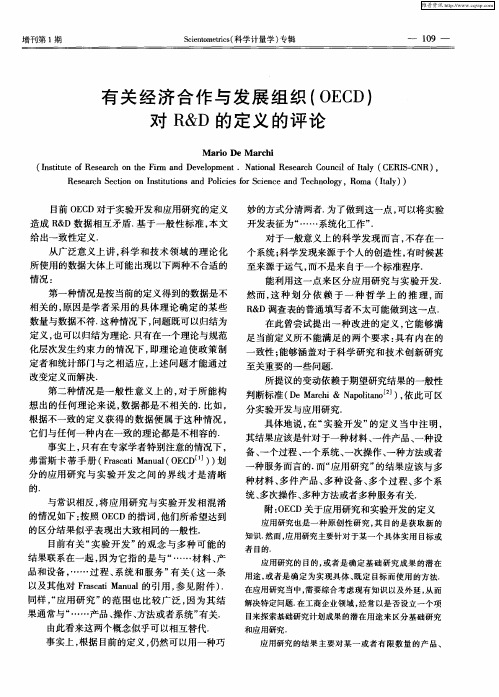
用途 , 或者是 确定 为实现 具体 、 定 目标而使 用 的方法. 既 在应用研究当中 , 需要综合考 虑现有 知识 以及外延 , 从而 解决特定问题. 在工商企业领 域 , 常以是否 设立一个项 经 目来探 索基 础研究计划成果 的潜在用途 来 区分基 础研究
足当前定义所不能满足的两个要求 : 具有 内在的
一
化层次发生约束力 的情况 下 , 即理论迫使政策制 定者 和统计 部 门与 之 相适 应 , 上述 问题 才 能通 过
改变定 义而解 决 .
致性 ; 能够 涵 盖对 于科 学研 究 和技 术创 新 研究 所 提议 的变 动依赖 于期望 研究结 果 的一般性
应 用研究也 是一 种原创 性研 究 , 目的是获 取新 的 其
的情况如下 : 按照 O C E D的措词 , 他们所希望达到 的区分结 果 似乎表 现 出大致相 同的一般 性 .
目前有关 “ 验 开 发 ”的观 念 与 多 种 可 能 的 实
结 果联 系在一 起 , 因为 它 指 的是 与 “ …材 料 、 … 产
知识 . 然而 , 应用研究主要针对 于某一个 具体实用 目标或
者 目的. 应用研究的 目的 , 或者 是确 定基础 研究 成果 的潜 在
品和设备 , ……过 程、 系统和服务” 有关 ( 这一条 以及其他对 Fa a au 的引用 , r ctM na s i l 参见附件 ) .
和应用研究 . 应 用研究 的结果 主要对 某一 或者 有限 数量 的产 品、
由此看来这两个概念似乎可以相互替代.
the organization for economic cooperation and development(经济合作与发展组织)
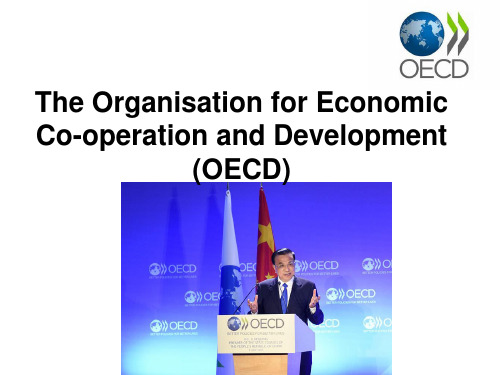
• The OECD provides a forum in which governments can work together to share experiences and seek solutions to common problems. They work with governments to understand what drives economic, social and environmental. They measure productivity and global flows of trade and investment. We analyse and compare data to predict future trends. They set international standards on a wide range of things, from agriculture and tax to the safety of chemicals.
Brief Introduction
• History: established in 1961 • Headquarters: Paris, France • Membership: 35 countries • Budget: EUR 370 million
经济合作与发展组织

领先指数
含义:预测世界最大经济体商业活动的工具。
发布时间:中午(欧洲大陆时间);在每月第一周的星期五发布数据,报告两个月前的活动。(例如,1月 的发布报告11月的领先指标。)
频率:每月一次。
来源:经济合作与发展组织(OECD)
OECD下调2014年全球GDP增长预期
经 济 合 作 与 发 展 组 织 ( O E C D ) 11 月 1 9 日 公 布 的 报 告 显 示 , 将 2 0 1 4 年 全 球 G D P 增 速 预 期 下 调 至 3 . 6 % , 此 前 5 月份OECD报告中的该项预期为4.0%。OECD称,此次下调的原因主要是发展中国家的经济情况有逐步转弱趋势。 同时,OECD预计2013年全球经济增......
国际税改
国际税改框架 国际税改框架支柱之一是将大型跨国企业部分征税权从企业注册地重新分配至企业经营与盈利地;另一支柱 是设立全球最低企业税率,结束各国企业税逐底竞争。 经合组织预计,通过双支柱国际税改框架,每年超过1000亿美元利润的征税权将转移至市场辖区;与此同 时,如果设定全球最低企业税率不低于15%,全球每年将新增约1500亿美元税收。 经合组织计划2021年10月完成税改框架剩余技术性工作,并于2023年落实计划。 国际税收改革谈判 经济合作与发展组织(经合组织)协调国际税收改革谈判近十年,旨在确保大型跨国企业在经营与盈利地纳 税 , 同 时 确 保 国 际 税 收 体 系 确 定 性 和 稳 定 性 , 以 适 应 经 济 全 球 化 与 数 字 化 。 经 合 组 织 秘 书 长 马 赛 厄 斯 ·科 尔 曼 表 示 , 国际税改框架并非消除税收竞争,而是为竞争设限,兼顾包括小型经济体等在内的各方利益。 协调谈判进展 2021年7月1日,经合组织发布公告表示,其协调谈判的双支柱国际税改框架已得到130个国家和司法管......
世界经济合作与发展组织(OECD)包润石副秘书长在第三届中国对外

世界经济合作与发展组织(OECD)包润石副秘书长在第三届中国对外投资合作洽谈会主论上的坛演讲如下:尊敬的国家发改委副主任张晓强先生,尊敬的国家开发银行副行长李吉平先生,尊敬的海外产业发展规划协会的副会长范春永先生,各位来宾,女士们,先生们,我非常荣幸能代表经济合作与发展组织参加第三届中国对外投资合作洽谈会,向你们表示感谢和祝贺!经合组织跟中国的合作范围已经很大了,我相信双方将来的合作,尤其是关于中国对外投资的情况跟经验,可以越来越大,我们互相学习对于双方都有利。
现在请允许我用英文再简单的介绍一下。
投资对于每一个国家来说都是一个很主要的驱动力,是经济发展和就业的驱动力。
无论是发达国家还是发展中国家,非常高质量的对外投资对于可持续的经济发展是非常重要的。
因此这次第三届中国对外投资合作洽谈会非常重要,中国海外发展规划协会组织的这次会议是非常重要的。
我们知道现在的经济情况是怎样的,还有G20会议当中也可以看到,现在我们所面对的困难,对于某一些国家要想真正从现在经济危机当中复苏要花很长时间。
今年和明年对于欧洲来说是负增长,对于美国来说,美国的经济增长我觉得不会超过2%。
去年增长还是比较快的,1.45万亿,但是比前一年的增长还是少了一些,我们可以看到现在经济和政治不稳定性还是存在的,2011年我们还会看到不断复苏的过程,所以我们必须重拾信心,不断的保持增长。
也可以看到世界投资的格局和地位正在不断变化,我们可以看到发展中国家,新兴国家,东南亚地区,拉丁美洲地区增长非常快,尤其是投资方面,还有很多新兴的发展国家也创造了更多的投资。
我们可以看到,来自于中国、印度、马来西亚、俄罗斯和巴西的对外投资是不断增长的。
来自新兴国家的投资者也不断的扮演着越来越重要的角色,并且不断把发展中国家融入国际社会当中和国际产业链中。
中国现在也成为一个外国直接投资的来源国。
1979年的时候,中国没有任何对外投资,但是中国改革开放之后,有超过24600亿的投资。
经济合作与发展组织(OECD)跨国公司指南
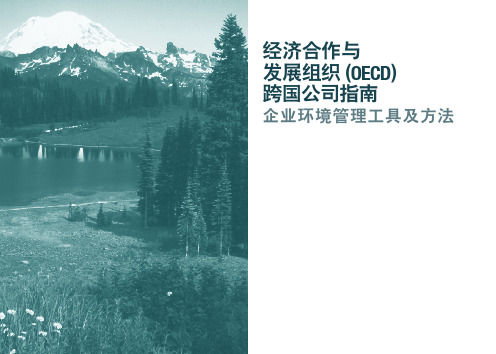
发展组织 (OECD)跨国公司指南企业环境管理工具及方法目 录前 言5环境和OECD跨国企业指南6企业责任与环境: 企业个案及挑战8将指南付诸实施:企业工具和方法91. 环境管理系统92. 公众信息及利益相关者的意见和建议123. 生命周期评估154. 预防措施185. 应急预防、应急准备和应急反应206. 不断改善环境绩效227. 环境教育与培训258. 为环境政策的发展做贡献28有用的链接31附录OECD跨国企业指南第五章: 环境6利益相关者参与“道德投资”决策14采用生命周期评价来降低环境影响17设计有效的风险信息交流19创建一种危机管理系统21案例研究: 一个鞋业回收计划24安全操作惯例培训26企业与其它公众社会团体之间的对话30前 言保护环境不仅有利于可持续发展,同时也能够服务当代人并造福后代人。
在2002年约翰内斯堡举行的世界可持续发展峰会上,来自世界各国政府的领导人都赞成加强环境领域合作的责任和义务。
此次峰会上,OECD关于对跨国企业的指南中指出了OECD对于推动这种合作责任和义务最希望采取的方法。
OECD关于跨国企业指南2000年修订版中明确表示,这些指导方针是使用国的共同标准。
这个指南适用于到目前为止OECD的30个成员国和9个非成员国。
世界上大部分的外国直接投资都来源于这些国家,而且主要跨国企业大部分也在这些国家。
许多的关于责任方面的商业行为标准也适用这些国家。
指南强调这些国家的政府只推广多国承认而且全面的标准,这就使得这些指南成为了世界上最重要的推动共同责任的手段之一。
指南把环境放在了很重要的位置,而且专门用一章来讨论企业环境绩效。
这也广泛地体现了包含在环境与发展里约热内卢宣言和21世纪议程中的原则和宗旨。
这个册子就相当于一个深层次的报告总结,旨在帮助企业、政府和民众在运用指南时寻求共同的环境绩效,同时为那些想实施指南并且提高环境绩效的企业提供详细的方法和手段。
报告已经登在了OECD的网站上/env/investment。
OECD科技与创新主要观点汇总

OECD科技与创新观点汇总OECD成立于1961年,目前共有35个成员国,其宗旨是经合组织的宗旨:促进成员国经济和社会的发展,推动世界经济增长;帮助成员国政府制定和协调有关政策,以提高各成员国的生活水准,保持财政的相对稳定;鼓励和协调成员国为援助发展中国家作出努力,帮助发展中国家改善经济状况,促进非成员国的经济发展。
自1963年以来,OECD相继编撰正式推出了5本手册,按出版时间顺序依次是弗拉斯卡蒂手册、TBP手册、奥斯陆手册、专利手册以及科技人力资源手册,统称为《弗拉斯卡蒂系列手册》。
这些手册涉及到科技统计的广泛领域。
其中奥斯陆手册是计量科技统计与经济结合的技术创新活动的标准和规范,到目前为止,OECD分别在1992、1997和2005年出版了三版用于指导创新调查的《奥斯陆手册》,第三版手册是OECD科技指标专家组和欧洲统计局科学技术创新统计组,以及科技创新领域的相关专家密切协作、耗时3年研制而成的,新版手册为在新的历史时期收集和解释科技创新收据提供了一种可进行国际比较的方法指南。
《奥斯陆手册》提出创新测度的方法有主体法和客体法两类。
主体法又叫创新预算法,聚焦于企业层面,关注的重点是创新的主体(企业),将企业作为一个整体,考察其创新行为和活动。
主体法通过测量企业在某一段时间内,花费在创新活动上的所有经费,来探究影响企业创新行为和创新产出的各种因素(如战略、创新的激励和障碍)。
这些活动包括已经执行的、可能会执行的和已经停止进行的创新活动。
由于利用主体法所收集的创新费用信息,能够与国民经济会计账户衔接起来,所以政府统计部门更偏爱这种方法。
客体法集中研究创新过程的客观产出,聚焦于项目层面,关注的重点是具有重大意义的技术创新,技术创新的重要程度通常由专家鉴定或是行业期刊及其它文献中的新产品预告予以确定。
客体法所收集的创新总费用,只包含某段时间内企业已经执行的创新费用,不包括已经停止进行,或正在进行的创新活动的费用。
新闻阅读答案经济合作与发展组织(OECD)公布了XX年的国际学生能力测试(PISA),.docx
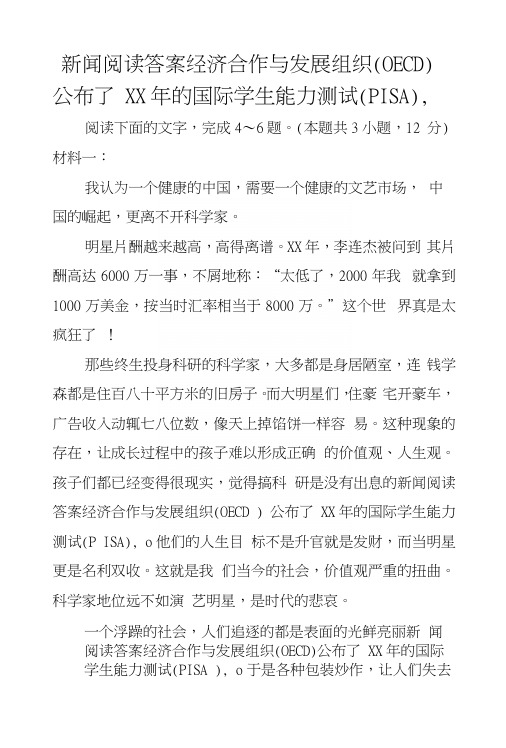
新闻阅读答案经济合作与发展组织(OECD) 公布了XX年的国际学生能力测试(PISA), 阅读下面的文字,完成4〜6题。
(本题共3小题,12 分) 材料一:我认为一个健康的中国,需要一个健康的文艺市场,中国的崛起,更离不开科学家。
明星片酬越来越高,高得离谱。
XX年,李连杰被问到其片酬高达6000万一事,不屑地称:“太低了,2000年我就拿到1000万美金,按当时汇率相当于8000万。
”这个世界真是太疯狂了!那些终生投身科研的科学家,大多都是身居陋室,连钱学森都是住百八十平方米的旧房子。
而大明星们,住豪宅开豪车,广告收入动辄七八位数,像天上掉馅饼一样容易。
这种现象的存在,让成长过程中的孩子难以形成正确的价值观、人生观。
孩子们都已经变得很现实,觉得搞科研是没有出息的新闻阅读答案经济合作与发展组织(OECD ) 公布了XX年的国际学生能力测试(P ISA), o他们的人生目标不是升官就是发财,而当明星更是名利双收。
这就是我们当今的社会,价值观严重的扭曲。
科学家地位远不如演艺明星,是时代的悲哀。
一个浮躁的社会,人们追逐的都是表面的光鲜亮丽新闻阅读答案经济合作与发展组织(OECD)公布了XX年的国际学生能力测试(PISA ), o于是各种包装炒作,让人们失去了自然和本真,浮躁的气息扩散到每一个角落,使得现代人已经不再关注社会的本源,而是追求虚无的奢侈浮华。
中国正处于转型时期,互联网变革的洪流又让人们惴惴不安,人们都在寻找精神依托。
我们需要能够给国人做正确价值导向的“名人”,而恰恰社会上又非常缺少这种角色的存在,有文化、有担当、有历史责任感的名人太少了。
正是因为没有真正的思想舵手,才使很多明星、网红爬到了时代之巅,负面影响将非常深远。
人们不得不思考:中国精神在哪里?中国复兴从何谈起?(选自陈中华博客)材料二:经济合作与发展组织(OECD)公布了XX年的国际学生能力测试(PISA),结果显示,美国“将来期望进入科学相关行业从业的学生比例”为38 %,中国只有16. 8%,还不及OECD国家的平均值。
大气卫生
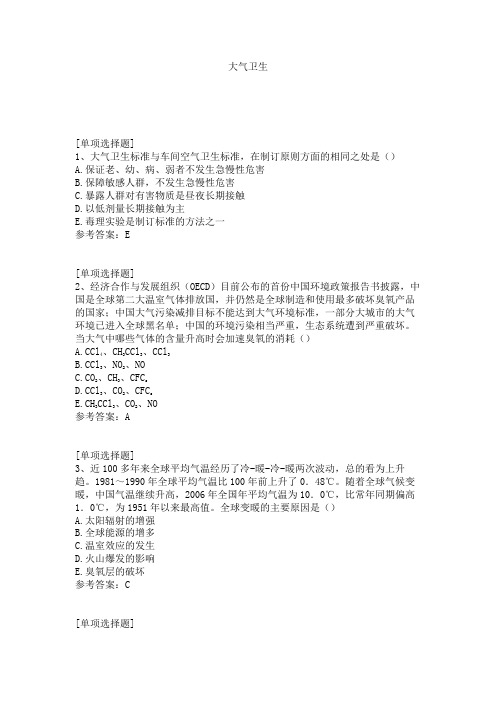
大气卫生[单项选择题]1、大气卫生标准与车间空气卫生标准,在制订原则方面的相同之处是()A.保证老、幼、病、弱者不发生急慢性危害B.保障敏感人群,不发生急慢性危害C.暴露人群对有害物质是昼夜长期接触D.以低剂量长期接触为主E.毒理实验是制订标准的方法之一参考答案:E[单项选择题]2、经济合作与发展组织(OECD)目前公布的首份中国环境政策报告书披露,中国是全球第二大温室气体排放国,并仍然是全球制造和使用最多破坏臭氧产品的国家;中国大气污染减排目标不能达到大气环境标准,一部分大城市的大气环境已进入全球黑名单;中国的环境污染相当严重,生态系统遭到严重破坏。
当大气中哪些气体的含量升高时会加速臭氧的消耗()l4、CH3CCl3、CCl3l3、NO2、NOC.CO2、CH3、CFCsl3、CO2、CFCsE.CH3CCl3、CO2、NO参考答案:A[单项选择题]3、近100多年来全球平均气温经历了冷-暖-冷-暖两次波动,总的看为上升趋。
1981~1990年全球平均气温比100年前上升了0.48℃。
随着全球气候变暖,中国气温继续升高,2006年全国年平均气温为10.0℃,比常年同期偏高1.0℃,为1951年以来最高值。
全球变暖的主要原因是()A.太阳辐射的增强B.全球能源的增多C.温室效应的发生D.火山爆发的影响E.臭氧层的破坏参考答案:C[单项选择题]4、某女性夏日外出游泳,回家后感觉脸部、颈部及背部等多处不适,仔细观察,皮肤出现红斑,米粒大小的丘疹及轻度的脱屑,触摸有疼痛感。
到医院就诊,诊断结果为皮肤晒伤。
具有红斑作用的紫外线波长是()A.200~275nmB.275~320nmC.300~400nmD.320~400nmE.400~500nm参考答案:B[单项选择题]5、某女性夏日外出游泳,回家后感觉脸部、颈部及背部等多处不适,仔细观察,皮肤出现红斑,米粒大小的丘疹及轻度的脱屑,触摸有疼痛感。
到医院就诊,诊断结果为皮肤晒伤。
- 1、下载文档前请自行甄别文档内容的完整性,平台不提供额外的编辑、内容补充、找答案等附加服务。
- 2、"仅部分预览"的文档,不可在线预览部分如存在完整性等问题,可反馈申请退款(可完整预览的文档不适用该条件!)。
- 3、如文档侵犯您的权益,请联系客服反馈,我们会尽快为您处理(人工客服工作时间:9:00-18:30)。
OECD Science, Technology and Industry Scoreboard/sti/scoreboardKEY FINDINGS: USABetween 2008-2010, the OECD as a whole suffered over 13 million job losses – about half of which occurred in the United States. The US faces extraordinary challenges – with national debt levels rising and unemployment high. Innovation is critical for equipping countries to respond to the pace and scale of globalisation and find new and sustainable sources of growth and competitiveness. STI Scoreboard data shows that US government and business investment in knowledge, research and innovation provides strong fundamentals for the future. But with the rise of the BRICS countries, there are a number of innovation policy areas that should be closely reviewed –public and private financing, direct (or indirect) support for business, ensuring continued technological advantage and the competition in the global jobs market for highly skilled science graduates.Where people lost their jobs, selected countries, 2008-09Relative contribution to change in total employment by major sectors of economic activityand national statistical institutes, June 2011.Statlink: /10.1787/888932484797 Continued strong investment – public and private sectorThe US has an unmatched national science and innovation system in terms of investment, size and reach. With nearly USD 400bn expenditure in 2009, the United States is the largest performer of research and development (R&D) in the world. Although China has recently become the second largest (USD 154 billion at purchasing power parity - PPP), the share of GDP that the United States devotes to R&D (2.7%) remains much higher than in China (1.7%). Personnel costs, which include researcher costs, in most economies account for the largest share R&D expenditures. This explains the close relationship between R&D as a percentage of GDP and number of researchers as a percentage of total employment.1Beyond government investment in R&D, the business sector in the United States also invests significantly (over 2% in 2008). The high ratio of researchers working in the business sector (over ten per 1000 employees) points to a density of innovation networks. This scale of investment gives the United States a very large critical mass. As scientific discovery increasingly involves the convergence of different fields, this weight of effort acts to attract top-talent from around the world as well as entrepreneurs who want to benefit from the scale that the US market.Source: OECD, Main Science and Technology Indicators Database, June 2011Statlink: /10.1787/888932485196A good regional spread of innovation activitiesMany of the leading firms in knowledge-intensive industries – such as ICT and the life sciences – are also concentrated in a limited number of regions in the world. Charting the world’s top 20 patenting regions for ICT, biotechnologies and nanotechnologies, the United States is unique in having a larger number of smaller hot spots from coast-to-coast as opposed to the concentrated activity that characterises many countries. This reflects a more integrated and widespread national system of innovation.23Innovation hot spots in ICT, biotechnologies and nanotechnologies, 2006-2009Top patenting regions by technology field as a percentage of the country’s patents in the fieldSource: OECD, REGPAT Database, June 2011.Statlink: /10.1787/888932485329The business R&D landscape in the United States is still dominated by large enterprises, though smaller entrepreneurial firms actively contribute to overall patenting activity.Business R&D by size class of firms 2009As a percentage of total BERDSource: OECD, Research and Development Database, May 2011. Statlink: /10.1787/888932486108World class science and research universitiesAcademic research in the US remains a reference worldwide, as shown by the number of normalised citations to United States academic publications. In absolute numbers the United States is the leading producer of publications in top journals, followed by the United Kingdom. If total publications areStatlink: /10.1787/836087047406Much of this scientific expertise resides in US research universities. 40 of the world top 50 universities with the highest research impact are located in the United States, with the remainder located in Europe. In the United States, some universities excel in a wide range of disciplines. Stanford University features among the top 50 for all 16 subject areas, and 17 other US universities feature in the top 50 in at least 10 scientific fields.4University hotspots – geographical distribution of highest impact institutions, 2009Custom Data, Elsevier, June 2011.Statlink /10.1787/8889324853105As a percentage of total employmentThe investment in learning and researchtranslates into human resources inscience and technology (HRST) who canplay a key role in innovation. In the US,HRST account for more than 35% of totalemployment in 2010 (over 50% women).HRST employees are more concentratedin services than manufacturing. HRSTgrowth rates in the US between 2003-2008 were around 2% as compared to1.20% employee growth in all sectors.In the US, four out of five researcherswork in business – over ten per 1,000employees compared to the OECDaverage of 6.Source: OECD, calculations based on EU Labour Force Survey; US Current Population Survey; Australian, Canadia, Japanese and New Zealander labour force surveys; Korean Economically Active Population Survey; China Labour Statistical Yearbook 2010; Indian National Sample Survey; and ILO, Laborsta Database, May 2011.Statlink: /10.1787/88893248584267Targeting new areas of growthThe United States has built a significant advantage in the key technologies for the future, although competition is mounting. It is the biggest investor in biotechnology R&D – spending 7% of total US Business Enterprise Research and Development (BERD) and has the highest number of active biotechnology firms – 6213. For the US and France, which spend the most on biotechnology R&D, approximately 88% of biotechnology R&D was performed by firms with over 50 employees.The US is the largest funder of health-related R&D at just over 0.3% of GDP. In the late 2000s the US led in health patenting with more than 40% of health-related PCT patent applications (EU second with nearly 29% and Japan third at just under 10%).Public funding of health-related R&D, 2010As a percentage of GDPSource: OECD calculations based on the Research and Development Database and national sources, May 2011. Statlink: /10.1787/888932486735Health-related patents, 1997-99 and 2007-09 As a percentage of total PCT patent applicationsSource: OECD, Patent Database, May 2011.Statlink: /10.1787/8889324867548Source: OECD, Patent Database, MayJune 2011. Statlink: /10.1787/888932486773Key issues:FinancingGiven the economic context, high unemployment and the pressures on government spending, a key question is how long can the US maintain its high level of public financing of R&D?Government budget appropriations for R&D, 2010As a percentage of GDPSource: OECD MSTI Indicators Database June 2011 Statlink : /10.1787/888932486659Beyond public funding, private financing (via bank loans, debt or equity financing and venture capital) is critical to stimulating new business and expanding existing ones. An OECD indicator using data from the World Economic Forum shows that bank financing became more difficult to obtain between 2007-2010. In the US, ease of access to bank loans declined significantly from 2007-2008 to 2009-2010.Venture capital funding in 2009, as a percentage of GDP, was highest in Israel, followed by the United States. However venture capital is increasingly sensitive to market cycles in terms of amounts investedand stages of investment. Under conditions such as today’s difficult financial environment, venture capital funds are investing in later stages, leaving gaps at the pre-seed and seed stages where profit expectations are less clear and risks much higher. Angel investment is the most significant source of outside equity for seed and early stage start-ups – filling the financing gap left by venture capitalists. A forthcoming OECD report High Growth Financing examines this in more detail.HRST mobilityOver a quarter of all new doctorates in science and engineering in the OECD are from the United States: 26.3% of the nearly 89,000 OECD total in 2009, slightly down from 28.6% in 2007. Higher education and research systems have become more internationalised over the past decades.In 16 out of 28 countries –and in the US in particular - the share of international and foreign students enrolled in science and engineering surpasses that of national students and the pattern is more pronounced at the doctoral level. It highlights a number of challenges for the US - firstly the need to raise domestic interest in key science and technology fields, especially as standards and reputation of universities elsewhere in the world improve. Secondly to ensure that highly skilled science graduates or doctorate holders contribute to research and innovation within the US economy. In the past the US has benefited from science and engineering graduates coming from a range of countries, including emerging economies. As employment and economic opportunities improve in these countries, the US will find itself competing in a much wider global market for these highly skilled science researchers.Direct and indirect support for businessTax incentives can be a cost-effective way to boost innovation in the business sector. Many countries, like the United States, Russia, France, fund large mission-orientated R&D in areas such as defense, health and the environment. However, some countries, for example Israel, are increasingly using a mix of direct government funding for R&D and indirect support through tax credits and subsidies. Taking both policy approaches into account the total investment of the United States falls below that of other countries like France, Korea and Canada.MSTI Database June 2011Technology edgeA new indicator on technological advantage in patent applications shows that the United States has begun to lose its technology advantage in ICT, an area previously dominated by the US. In 2007-2009 the share of ICT-related patents applied for by Asian countries (China, Korea, Japan and Singapore) rose –China had the largest increase in ICT-related PCT filings in the 2000s.Revealed technological advantage in ICT, 1997-99 and 2007-09Index based on patent applications filed under the PCT910Statlink: /10.1787/888932487970OECD terrestrial mobile wireless broadband subscriptionsper 100 inhabitants, by technology, June 2010Wireless broadband is widely recognised as an important platform for innovation given the growing popularity of smartphones and tablet computers in business (and social) activity and an ever increasing market for new content and services from application storesWireless broadband subscriptions in OECDcountries had exceeded half a billion by the end of 2010, an increase of more than 10 percent on June 2010. The United States falls behind first tier countries like Korea and Japan in wireless broadband connectivity.Source: OECD, OECD Broadband Portal June 2011 Statlink: /10.1787/888932486925Global environmental challengesIn absolute terms the United States is the second largest funder of R&D into energy and the environment with USD 3.7 billion just behind Japan with USD 4.2 billion. However this represents less than 2% of its overall budget. Finding cleaner, affordable and reliable energy sources and promoting sustainable growth is global area that should not neglected.Some governments have adopted concerted policy measures in alternative energy areas. For example innovation in alternative fuel vehicle technologies has accelerated thanks to a mix of policy instruments –eg fuel efficiency standards, after-tax fuel prices. The US has increased focus on AFV innovation, contributing 689 AFV patents, but lags behind Germany (965) and Japan (3195). China is also increasing innovation activity in AFV technologies, though its level of patents in absolute terms is still small.---------OECD Science, Technology and Industry (STI) Scoreboard - major world trends in knowledge and innovation. It analyses a wide set of indicators of science, technology, globalisation and industrial performance in OECD and major non-OECD countries (notably Brazil, the Russian Federation, India, Indonesia, China and South Africa) and includes some experimental indicators that provide insight into new areas of policy interest.ContentsChapter 1. Knowledge Economies: Trends and FeaturesChapter 2. Building KnowledgeChapter 3. Connecting to KnowledgeChapter 4. Targeting New Growth AreasChapter 5. Unleashing Innovation in FirmsChapter 6. Competing in the Global Economy /sti/scoreboard.11。
